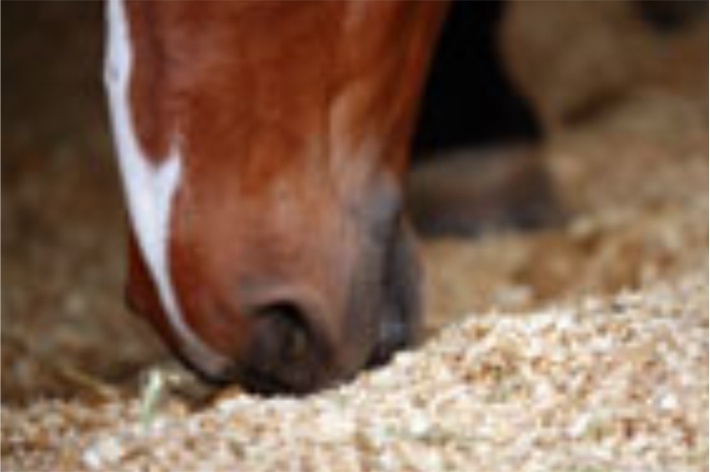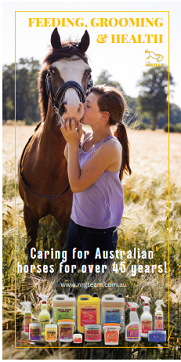By Mariette van den Berg, B. (Hons), MSc. (Equine Nutrition)
MB Equine Nutrition Consultancy – www.mberg.com.au
Colic is one of the most feared digestive disorders in horses. There are many horse owners that experienced first-hand or know of a horse that suffered or even died of colic.
Colic is defined as abdominal pain and can be caused or brought on by many factors including abrupt dietary changes, stress, water deprivation, feeding straight after exercise, erratic management and anything un-natural ingested.
When ingestion of large amounts of sand or dirt is the cause of abdominal pain in a horse we talk about the so-called sand colic. Horses may ingest sand or dirt to self-supplement, self medicate and bind toxins or other substances. This behaviour may be considered normal as observational studies in the wild have shown that a number of animals appear to self-medicate themselves at certain times and in a number of different ways. However, horses kept on eroded pastures may start eating sand or dirt because there is no biomass left to eat. In addition, horses may ingest sand or dirt out of boredom. If this happens, horses will show a pattern where they will repeat the behaviour with no obvious function (stereotypical behaviour).
Horses will always ingest a certain amount of sand or dirt that clings on to the plants that they consume or when they eat the spilled hard feed from the ground. The sand will pass through the digestive tract with the food and is passed in the manure. When sand starts to accumulate in the digestive tract it can lead to irritation of the intestinal lining, diarrhoea, weight loss and colic. In the case of large amounts of sand, the weight of the sand can reduce the motility and hinder the passage of sand, which causes more sand to accumulate and obstruct the digestive tract of the horse. Most of the sand accumulates in the horse’s large colon, which probably is due to the motility patterns of the large colon.
If you suspect your horse is eating sand, or you would like to check if your horse is passing sand, you can take a faecal sample and mix it with water in bucket or in a plastic bag. After you let it settle you can check if the sand gravitated to the bottom of the bucket or bag. However, this only tells you that the horse ingested sand and that the sand passed through the tract. To determine if there is still sand in the digestive tract your veterinarian needs to examine your horse. Your vet can diagnose by listening to the abdomen with a stethoscope and hear if sand is moving. In some cases they can take radiographs or ultrasound images to determining the movement of sand and/or locate sand obstructions.
Most cases of sand colic can be treated similarly to food impaction colic. Horses may need sedative medication to reduce the pain which helps the horse to relax and prevent rolling. Medical treatment involves stomach drenching with electrolytes and paraffin oil or another laxative.
Feeding or drenching with Psyllium husks can also help moving sand through a horse’s digestive system. Psyllium husks are high fibre portions of the seeds of the Psyllium plant (Plantago ovata), which are native to India and Pakistan. Psyllium is a laxative and has the ability to swell, capture and move sand out of the digestive tract with manure. However, addition of Psyllium may not be effective enough to increase fibre content in the digestive tract and bind the sand. Horses evolved primarily as grazing herbivores, eating a diet high in fibre, which allow horses to also adapt to the Psyllium husks. A combination of Psyllium with pre- and probiotic have been suggested to assist normal motility in the digestive tract and increase faecal sand output. However, more research is necessary to determine the use of Psyllium husk for the prevention of sand accumulations in horses.
Psyllium may work is some horses and not in others. It is advised to feed Psyllium husks (0.5 – 1 g per kg body weight per day, depending on severity and adaptation of the horse) for only 2 to 5 consecutive days. You can repeat the treatment once a month if your horse is kept on sandy pastures or shows signs of frequently sand or dirt eating behaviour. There are various commercial Psyllium husk products available for horses. However you can also source them from human health stores. You should not fully rely on Psyllium husks, when you don’t see any improvements it is best to consult with your veterinarian for the best treatment. In severe cases horses with sand impaction may need surgery.
Sand colic is preventable, it is best to properly manage your pastures and prevent your horses eating of sandy grounds while feeding hard feeds by placing mats or feeders. Environment and feeding enrichment may also assist with preventing boredom and stereotypical behaviour in your horse.
If you would like to see more nutritional articles and have particular topics that you would like to see discussed in the Equine News, email MB Equine Nutrition Consultancy (www.mberg.com.au) or contact Equine News directly.





































